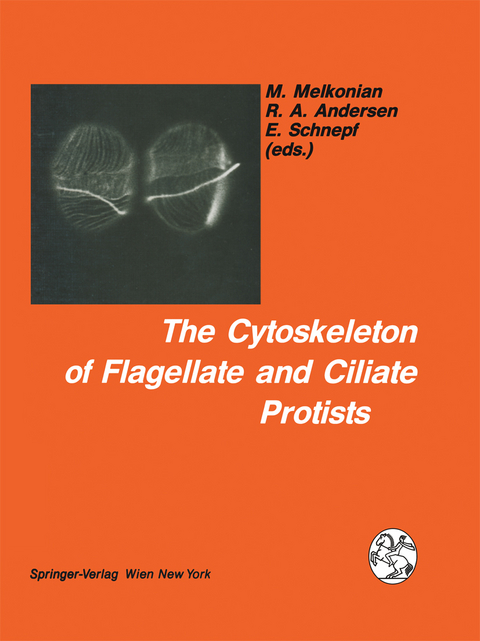
The Cytoskeleton of Flagellate and Ciliate Protists
Springer Wien (Verlag)
978-3-211-82294-4 (ISBN)
The concept of examining protists, and specifically the flagellar apparatus/cytoskeleton, from both a cell/molecular viewpoint and a systematic viewpoint is novel. Together these viewpoints show the unique and widespread occurence of new information and provide a better understanding of the evolutionary relationships among the diverse organisms placed in the Protists. Readers will find new and exciting information in one authoritative volume, providing a single text that addresses an important topic in contemporary protistology.
Protists are fascinating organisms that have diversified and protozoologists. For example, phycologists use the evolutionarily to inhabit most of the biosphere. Their term "basal body" while protozoologists use "kine tosome"; mycologists were indifferent and used both cytoskeleton is the primary reason that such a diver sification is possible. Microtubules provided freedom terms! from the constraint of prokaryotic cell walls and they As knowledge increased, it became more and more were organized in various cytoskeletal configurations. apparent that the organisms studied in the classical The nine pairs plus two flagellum, a major component fields did not fit into monophyletic lineages. And when of many protistan cytoskeletons, gave a new meaning efforts were made to organize the protists into a phy to the word motility beginning at least one thousand logenetic classification, it became strikingly apparent million years ago. Associated with the development of that we needed a common vocabulary. Until such a the flagellum were new contractile and noncontractile common vocabulary exists, it will remain difficult to proteins that are necessary for control and manipu compare studies by scientists from different fields, it lation of the flagella. As the new protists ventured out will be difficult to identify homologous structures into new habitats and filled new niches, they evolved among protists, and the historical barriers created by new ways of sensing their surrounding environment. individual fields of mycology, phycology and proto Phototactic responses became tightly coupled with the zoology will remain.
Terminology and nomenclature of the cytoskeletal elements associated with the flagellar/ciliary apparatus in protists.- Why do tubulin gene families lack diversity in flagellate/ciliate protists?.- Transmembrane signaling in cilia and flagella.- Development apparatus during the cell cycle in unicellular algae.- An update on fibrous flagellar roots in green algae.- Mechanisms of flagellar propulsion. A biologist's view of the relation between structure, motion and fluid mechanics.- High-speed video analysis of the flagellar beat and swimming patterns of algae: possible evolutionary trends in green algae.- Flagellar and cytoskeletal systems in amitochondrial flagellates: Archamoeba, Metamonada and Parabasala.- An ultrastructural comparison of the mitotic apparatus, feeding apparatus, flagellar apparatus and cytoskeleton in euglenoids and kinetoplastids.- The flagellar apparatus and cytoskeleton of the dinoflagellates. A comparative overview.- The implications of recent descriptions of kinetic structure to the systematics of the ciliated protists.- The cytoskeleton of chromophyte algae.- Vischeria stellata (Eustigmatophyceae): ultrastructure of the zoospores, with special reference to the flagellar apparatus.
| Erscheint lt. Verlag | 6.12.1991 |
|---|---|
| Zusatzinfo | VII, 167 p. |
| Verlagsort | Vienna |
| Sprache | englisch |
| Maße | 210 x 279 mm |
| Gewicht | 716 g |
| Themenwelt | Naturwissenschaften ► Biologie ► Botanik |
| Naturwissenschaften ► Biologie ► Mikrobiologie / Immunologie | |
| Naturwissenschaften ► Biologie ► Zellbiologie | |
| Schlagworte | algae • Cell • cell cycle • Cytoskeleton • Development • Einzeller • Endoplasmatisches Reticulum • Evolution • Gene • Membrane • mitochondria • Roots • Systematics |
| ISBN-10 | 3-211-82294-1 / 3211822941 |
| ISBN-13 | 978-3-211-82294-4 / 9783211822944 |
| Zustand | Neuware |
| Haben Sie eine Frage zum Produkt? |
aus dem Bereich


